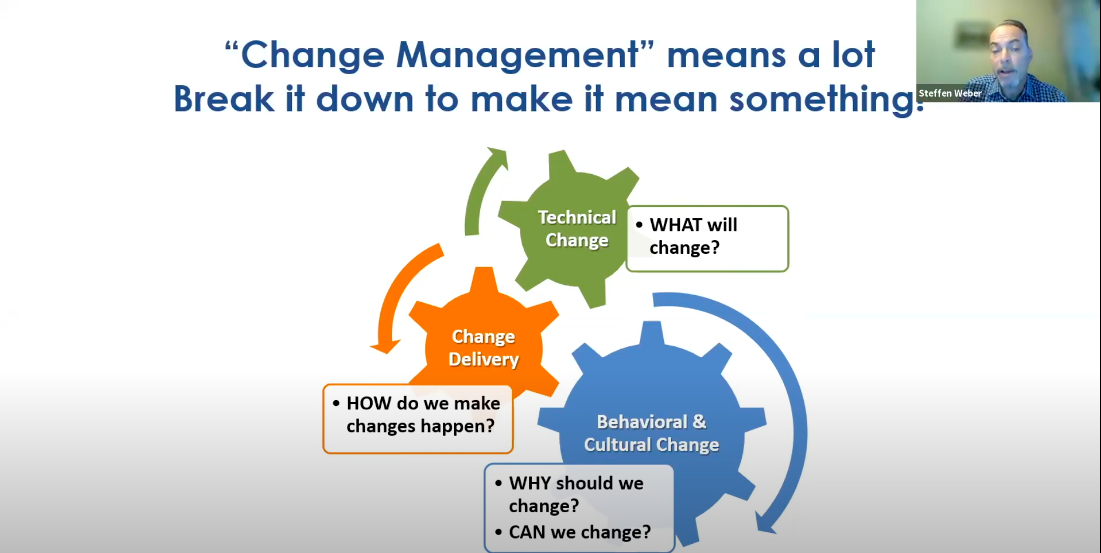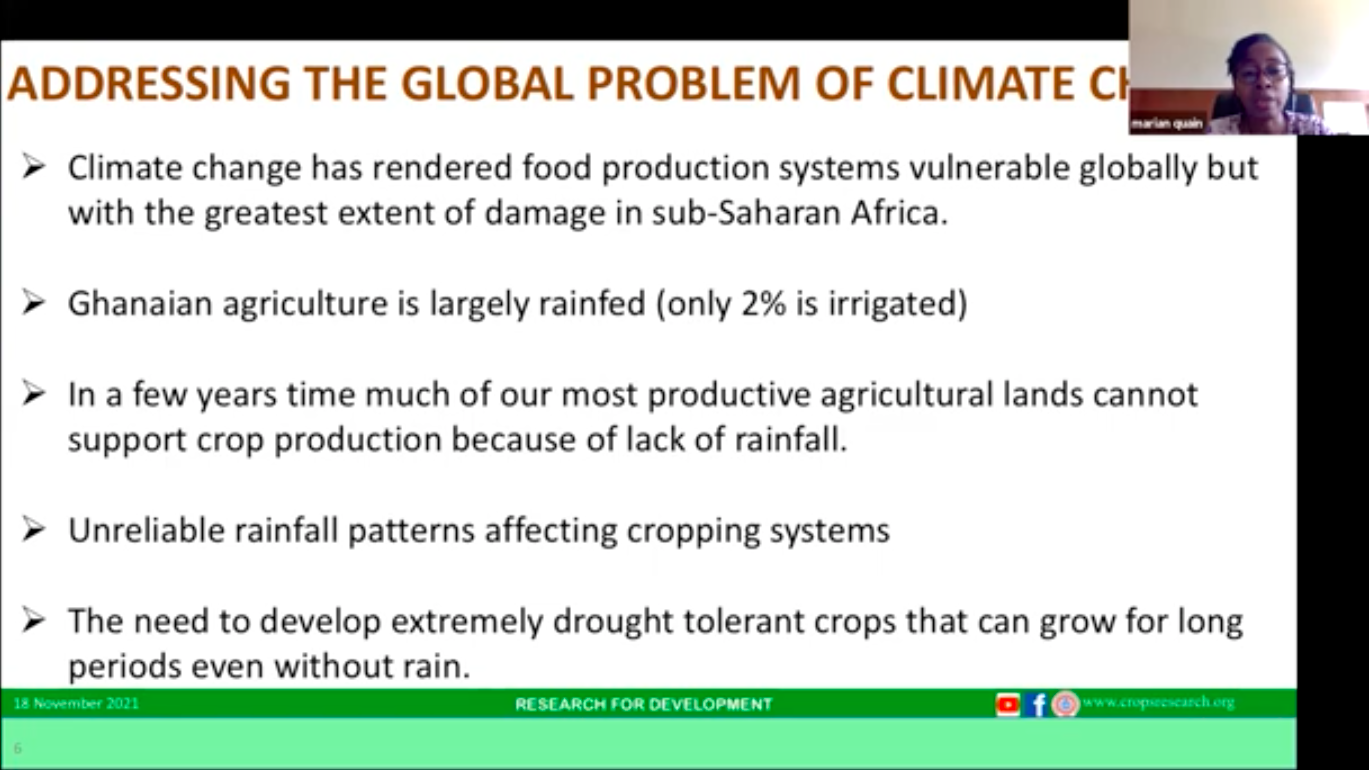 As the CGIAR and NARES breeding community push towards increased genetic gains and reducing the weighted average age of varieties, the CGIAR Excellence in Breeding’s (EiB) 2021 Virtual Meeting allowed participants to share ideas on driving implementation for impact.
As the CGIAR and NARES breeding community push towards increased genetic gains and reducing the weighted average age of varieties, the CGIAR Excellence in Breeding’s (EiB) 2021 Virtual Meeting allowed participants to share ideas on driving implementation for impact.
Partners from across the CGIAR and NARES inspired the audience by sharing their contributions of not only what they’re implementing — but where they’re heading. Here are some key takeaways from Inspire > Implement > Impact: EiB Virtual Meeting 2021:
Partners are inspired to achieve excellence
On the first day, EiB Director Michael Quinn discussed the direction EiB is heading to fulfill CGIAR breeding goals — forward. Quinn highlighted the product-oriented approach and the importance of product performance because the combination will determine EiB’s pathway to farmer-preferred varieties and a weighted age average that is less than 10 years. For Quinn, "the pressure is on, and the consequences are going to be very real if we’re unable to meet the challenge." That is why EiB and other CGIAR partners are readying for the One CGIAR transition. It means CGIAR breeding institutions can deliver better results, faster.

Michael Quinn (EiB) emphasizing the importance of EiB’s contribution to CGIAR’s breeding goals.
One CGIAR Director of Genetic Innovation, Barbara Wells, explained that the One CGIAR system “marks a significant transformation in the way we operate to improve food, land and water systems.” However, removing the walls of the traditional CGIAR system will require the principles of change management.
We have the skills, resources and mindset to drive implementation
On day two, Steffen Weber discussed the principles of change management. Weber highlighted that the "way we do breeding today will not allow us to meet that challenge, and it's a huge one." However, challenges such as the lack of centralized data management and access issues, introduce a new set of opportunities, particularly for NARES breeding programs.
For Uganda's National Agricultural Research Organisation (NARO-Uganda), and the Kenya Agricultural & Livestock Research Organisation (KALRO), their case studies showed they are already transforming some barriers into successes. NARO’s change management journey has allowed breeding programs to link their strategic aims to their product profiles and breeding processes. In turn, the program's change management mindset has resulted in leadership determined to co-fund their modernization efforts. For KALRO and others, implementing the Breeding Costing Tool provided a structural outline of breeding costs that can improve efficiency and planning.
When it comes to transforming for impact, change management brings breeding programs one step closer to delivering crop varieties at an accelerated rate to meet Crops to End Hunger (CtEH) requests and the Sustainable Development Goals (SDGs). As CIP’s Hugo Campos described in his case study on the CIP-NARS SweetGAINS breeding network, “creating a climate for change means building a guiding coalition… creating a vision… communicating the vision and empowering others to act.”

Steffen Weber explains the two big questions everyone needs to ask in behavioral & cultural change management: Why should we change? And can we change?
We are transforming for impact
On the final day, participants reflected on what transformation means through the eyes of CGIAR’s partners. GIZ Germany’s Sarah Schmidt explained that the transformation to “have better varieties in farmers’ fields, faster,” means farmers know about these seeds, that also women and other vulnerable groups are reached by the seeds, that there are enough quality seeds for the new varieties, and that these new varieties perform the same under farmer management as they do on the station. These are exactly the goals EiB and partners are positioned to reach — with CtEH funds helping overcome barriers.
So how will CGIAR’s organizational transformation help us reach this breeding transformation? Leads of three initiatives in CGIAR’s new 2022 portfolio described their goals and how they will help deliver EiB services.
Understanding what varieties farmers need will be done through the Market Intelligence and Product Profiling Initiative (MIPPI). MIPPI is rewriting the definition of market intelligence as the “strategic information on future crops’ market segments and trade priorities aligned to the needs and preferences of farmers, aggregate business and consumers,” said initiative lead Matty Dumont from the International Rice Research Institute (IRRI).
Alongside MIPPI, the Network 4 Enabling Tools, Technologies, and Shared Services (N4ETTS) initiative institutionalizes breeding improvement services within One CGIAR. These include many EiB services related to supporting improved strategy, digitization and smarter use of more data through systems and platforms like Enterprise Breeding System (EBS).
And the Accelerated Breeding Initiative (ABI) will ensure big picture goals can be met through refocusing products based on MIPPI’s insights, establishing coordinated approaches to trait discovery and deployment, defining and implementing clear stage gates, transforming CGIAR-NARES-SME partnerships, and more.

CSIR's Marian Quain explaining the relationship between crop breeding and Ghana's climate change situation.
Change is hard but nothing is impossible
Clearly, great progress is being made by partners. Changes are happening within programs. And those programs are getting better at managing that change. But most importantly, CGIAR and NARES breeding programs are demonstrating a mindset where nothing is impossible and impacts are in sight (see week two’s Stories of Excellence sessions).
As Michael Quinn summarized, “the people who have gathered here are helping to steer the direction of global public breeding. And when we take these hearts and minds and we combine them with the best technologies and practices, we will be sure to build a legacy that we can be proud of. With this commitment, the table is set for real results in farmers’ fields.”
More info:
-
Watch the sessions here: https://www.youtube.com/playlist?list=PLZ0lafzH_UmeV37Tk3fY2LMjQDXHELvbE
-
Watch the Stories of Excellence here:
-
Scalable management system for market-oriented variety development in Cassava – IITA/NaCRRI
-
Seven habits for a highly effective breeding program – IRRI’s continuous improvement approach – IRRI
-
Costing of breeding programs: Results and perspectives from NARES Rice Programs – ZARI/NARO/DR&SS
-
Progress in optimizing wheat breeding pipelines at CIMMYT – CIMMYT
-
Introducing the Breeding Informatics Network (BrIN) – EiB/Cornell University
-
Accelerating pre-breeding selection in rice through high-throughput genotyping – PhilRice/IRRI/EiB
-
Transition from targeted biofortification breeding to mainstreaming in CGIAR breeding programs – HarvestPlus/partners
-
Characterization of rice quality traits to improve breeding for Latin America and the Caribbean – FLAR/University of Illinois at Urbana-Champaign
-----
Story by Misha Nicholas, EiB Junior Communications Consultant. This story reflects the information and views of the authors or quoted individuals only. Special thanks: to EiB project funders including the Bill & Melinda Gates Foundation (BMGF), the Foreign, Commonwealth & Development Office (FCDO), the United States Agency for International Development (USAID), the German Agency for International Cooperation (GIZ), the Federal Ministry for Economic Cooperation and Development (BMZ Germany), the Australian Centre for International Agricultural Research (ACIAR) and our presenters and partners.